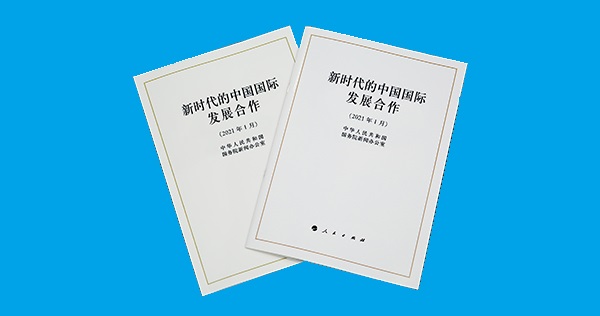The white paper "China's International Development Cooperation in the New Era" released on the 10th of this month replaced "foreign aid" with "international development cooperation" for the first time, fully demonstrating the trends and characteristics of China's international development cooperation.
Total words2151About6minutes
Authors: Yue Jun Han, Julia Sun
On January 10, 2021, the State Council Information Office releasedWhite Paper on "China's International Development Cooperation in the New Era", officially replaced "foreign aid" with "international development cooperation". And international development cooperation is defined as: "Under the framework of South-South cooperation, China conducts bilateral and multilateral international cooperation in the field of economic and social development, including humanitarian assistance, through foreign aid and other means."
Together with the "Foreign Aid" white papers released in 2011 and 2014, the three released white papers fully introduced the development history and achievements of China's foreign aid from the 1950s to the present, as well as the evolution of the foreign aid management system, and also demonstrated China's international Trends and characteristics of development cooperation.
Expand the scale and optimize the composition of aid funds
Before 2009, China's annual foreign aid was 4.2 billion yuan. From 2010 to 2012, the annual average reached nearly 30 billion yuan. From 2013 to 2018, the average annual foreign aid funds increased by more than 40%, reaching 45 billion yuan, about 7 billion US dollars. This makes China the seventh largest donor to international development in the world after the United States, Germany, the United Kingdom, Japan, France and Turkey.
The composition of aid funding is also changing. my country's foreign aid funds consist of three parts: gratuitous aid, interest-free loans and concessional loans. Before 2009, the proportion of free aid was about 40%, and the proportion of interest-free loans and concessional loans was about 30%. From 2010 to 2012, the proportion of preferential loans increased to about 55%, the proportion of interest-free loans dropped from nearly 30% to about 8%, and the proportion of free aid decreased slightly. From 2013 to 2018, interest-free loans continued to decline to about 4% of foreign aid funds, while the proportion of free aid increased to the highest point of 47%, and together with preferential loans accounting for 49%, it became the main form of China's foreign aid.
"Soft" projects are gradually increasing
According to the 2011 white paper, before 2009, complete sets of projects were the main form of foreign aid, accounting for 40% of funds, mainly helping recipient countries build production and civil engineering projects. From 2010 to 2012, new types of aid such as ecological protection and trade facilitation were gradually developed. Since 2013, packaged projects are no longer the main form of aid. At the same time, the traditional "China's self-construction" model has also changed to "aid recipients' self-construction", helping some qualified recipient countries to improve their independent construction capabilities.
As "soft" projects, such as technical cooperation and human resources construction, the number of projects and the number of beneficiaries continue to increase. From 2013 to 2018, the average annual number of beneficiaries of various training programs has doubled. The number of technical cooperation countries expanded from 61 in 2010 to 2012 to 95, with an average annual increase of 20% in the number of projects. From 2013 to 2018, more than 20,000 foreign aid volunteers were dispatched, compared with only 405 before 2009.
International development cooperation is positioned in South-South cooperation
Since 2013, the most important change in aid methods is reflected in the promotion and development of the South-South cooperation model. South-South cooperation is the basic positioning of China's international development cooperation, and it is also an important channel for developing countries to improve their development level and development capabilities. Since 2013, China has successively established cooperation institutions or mechanisms such as the South-South Cooperation Assistance Fund, the South-South Cooperation and Development Institute, the International Development Knowledge Center, and the “Belt and Road” South-South Cooperation Program on Climate Change.
By the end of 2019, China had pledged US$3 billion to support South-South cooperation funds, and cooperated with international organizations to carry out 82 South-South cooperation projects, involving agricultural development and food security, poverty reduction, maternal and child health, health response, education and training, and post-disaster reconstruction , immigration and refugee protection, trade promotion aid and other fields, making South-South cooperation an indispensable driving force in the field of international development, and playing a positive role in supplementing and balancing the original international aid dominated by North-South cooperation.
Closely link international development cooperation with national development strategies
The 2011 and 2014 white papers focused on the implementation and results of China's foreign aid, but did not incorporate foreign aid into the framework of the country's overall development strategy. To a certain extent, it reflects that the role of foreign aid was relatively single in the past, and the results were limited to the field of aid.
The 2021 white paper is a new one, with the establishment of the China International Development Cooperation Agency as a milestone, closely integrating international development cooperation with national development strategies and initiatives, making foreign aid an important carrier of international exchanges, and an important step for China to carry out international cooperation and jointly build global development. Important way of partnership. The white paper demonstrates the contribution of foreign aid in the theoretical practice of jointly building a community with a shared future for mankind, the "Belt and Road" initiative, and high-quality green development. Its impact has spread from aid and international development to economics, trade, and national governance.
Integrating international ideas and innovative cooperation models
Since 2013, China has comprehensively introduced international development concepts. The 2021 white paper adopts some achievements, showing that international development concepts and goals have been seamlessly connected with China's foreign aid: carry out projects to promote gender equality, strengthen the protection of women's rights and interests in recipient countries, and support women's capacity building; share governance experience with other developing countries , and carry out capacity building through bilateral and multilateral cooperation mechanisms; promote sustainable and innovative economic growth; aiming at the various goals of the United Nations 2030 Agenda for Sustainable Development, sort out the achievements of China's foreign aid.
Results have also been achieved in the field of international humanitarian assistance. From 2013 to 2018, China provided emergency humanitarian assistance to 60 countries. Since the outbreak of the new crown epidemic in 2020, China has provided assistance in various ways to 150 countries and 20 international organizations, effectively supporting the local fight against the epidemic and reducing global risks.
The 2021 white paper shows that China will adopt flexible methods such as dialogue and consultation, tripartite cooperation, and donation and financing in international development cooperation. It can be predicted that China is not only an active participant in the field of international development, but also an active explorer of innovative cooperation models, and a thinker and promoter of the future direction of international development cooperation.
While sharing the overall picture and development history of China's foreign aid, the three white papers also have small shortcomings. The data in the white paper are relatively macroscopic, lacking country-specific and annual data of recipient countries. As a result, some foreign institutions estimated the scale and development trend of China's foreign aid through media reports and model calculations, which inevitably deviated from the facts. Improving the foreign aid statistics system and carrying out data sharing and technical exchanges should be a task that needs to be improved in future international development cooperation.
This article was first published on the WeChat public account "International Development Observation". All rights reserved, please indicate the author and source when reprinting.
References
Zhang Chao and Tang Yuxuan, What Does a New White Paper Tell Us About China's International Aid? https://thediplomat.com/2021/01/what-does-a-new-white-paper-tell-us-about-chinas -international-aid/
Past review
- 2020 Development Cooperation Highlights of DAC Donor Countries
- New Technologies Empower the UN Sustainable Development Goals
- Joining the Global COVID-19 Vaccine Initiative: A Win-Win for China and the World
- WFP's Nobel Peace Prize: A Compelling Justification

